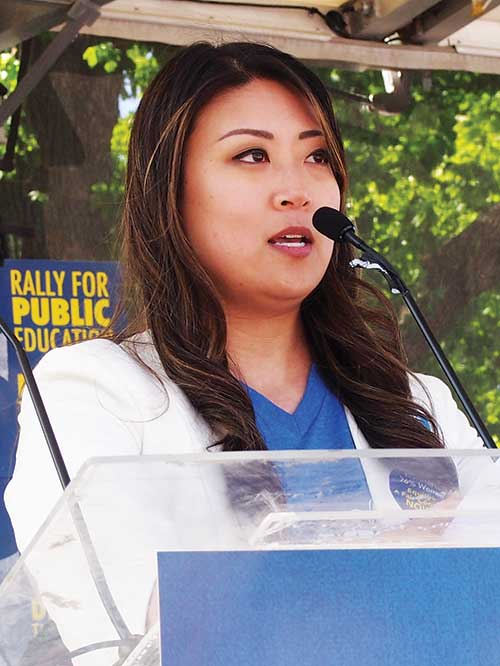Advocates call for bill to increase state education aid, fix cost estimates
Legislators are trying once again to update decades-old foundation budget

The third time may be the charm: Legislation designed to infuse new dollars into public school districts was passed by the Senate twice last year, but never implemented. Now advocates are trying again to push through a bill that could fix the financial woes of Boston Public Schools and other districts by updating the formula that the state uses to determine minimally adequate school budgets — which also impacts how much the state contributes
Jessica Tang, Boston Teachers Union president, was among those who spoke in favor of the bill at a State House hearing last week.
“The decline of state funding in Boston has had a hugely detrimental impact on our ability to serve many of the state’s neediest and most vulnerable students,” Tang said. A Trump White House further jeopardizes school budgets, with sizable slashes expected in federal education funding for states and cities.
The bill in question is An Act Modernizing the Foundation Budget for the 21st Century. In 2015, a bipartisan review commission, chaired by bill sponsor Sen. Sonia Chang-Diaz, reported that the foundation budget had not been updated since 1993 and failed to anticipate the costs of modern schooling.
The Foundation Budget Review Commission determined that these foundation budget calculations underestimate the actual costs of educating English Language Learners and students living in poverty and fail to account for the rising costs of health care and special education. The overall impact: Public education is underfunded by $1 billion to $2 billion per year, according to FBRC findings.
Supporters at the State House included legislators and parents as well as teachers union and education reform group representatives, which Sen. Sonia Chang-Diaz said is a promising sign.
“The consensus shown today in support of fixing the FBRC is unprecedented,” Chang-Diaz said. “It’s not every day you see the Boston Teachers Union, the Boston Superintendent’s office and Boston School Committee on the same side of the table, let alone Democrats for Education Reform and the teachers unions.”
Dissenters include Jim Stergios, executive director of the Pioneer Institute, who told the Boston Herald that he does not accept the FBRC’s estimates on the size of rising health care costs and that measures to increase school funding must be paired with measures that change spending patterns.
“Money without reforms is meaningless,” Stergios said. “The commission’s findings were skewed by its composition and especially by assumptions the commission made concerning the management of health care costs and other issues.”
View from the top
Governor Charlie Baker’s education budget this year incorporates some FBRC recommendations by increasing school healthcare funding.
“Governor Baker was pleased to sign a balanced budget that funds aid for local schools at a historic high of over $4.7 billion, including a $25 million increase toward school healthcare costs amounting to the broadest expansion of the Foundation Budget since its adoption nearly 25 years,” said Billy Pittman, Baker’s press secretary, in a statement.
Chang-Diaz said that while Baker’s budget indicates awareness of the need to adjust spending to meet unanticipated education costs, it addresses them more slowly than the proposed foundation budget bill would do.
“Governor Baker has signaled that he recognizes a need for Foundation Budget reforms. His budget proposal earlier this year made reference to the bipartisan recommendations of the commission, by making a small adjustment to the health care projection for schools. But the Governor’s proposal would take literally 100 years to phase in the full recommendations,” Chang-Diaz said in a statement to the Banner.
Balancing budgets
The foundation budget relies on a formula to estimate how much it costs a school to educate its students, given each student’s needs category (for instance, special education services), grade and other areas of school spending. The state always provides 17.5 percent of the calculated budget, then requires cities to contribute based on their presumed wealth. Any funding gaps that remain are filled by the state.
During her testimony, Tang said that it is not enough to update assessments of how much schools really need — there also must be updates to assessments on how much a city can pay. State assessments of municipal wealth are based on property values and incomes, and the assumption that the city can tap into these two revenue sources. But in Boston that is not fully the case — there is no city income tax, the state’s Proposition 2.5 limits city property tax levels and about 50 percent of Boston’s high-price land is not touchable by property tax, due to tax exemptions given to nonprofits.
As such, even if the foundation budget was updated, the state would keep assuming Boston could supply fiscal support at this high level. It would take several years — essentially the length of a student’s high school career — before that change triggered increased state monetary allocation to Boston, said a spokesperson from Sen. Chang-Diaz’s office. A companion bill, S.220, would amend this by capping increases in required municipal contributions for districts that meet certain specific criteria, which would then prompt the state to provide more. This cap on percentage increases would apply only for districts that meet three conditions: the district already spends above the minimally required contribution level (as Boston has been doing), has a high concentration of students in poverty and has not received any additional foundation aid (that is, the aid it received from the state, as directed by foundation budget calculations, was not higher than that of the previous year).






